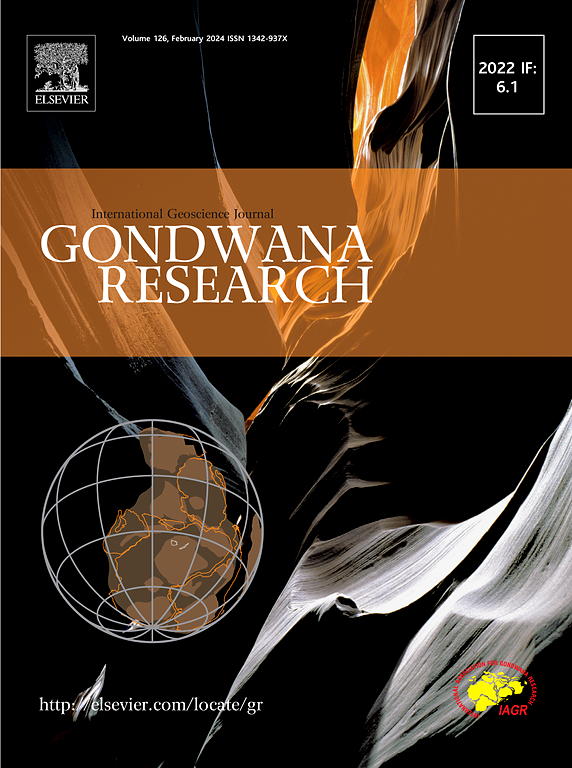伊比利亚中部和西北部的地壳尺度剖面:阿尔卑斯压缩期间的变形机制和转移
IF 7.2
1区 地球科学
Q1 GEOSCIENCES, MULTIDISCIPLINARY
引用次数: 0
摘要
大陆被动边缘的构造反转、造山带的形成和板块内山脉的变形转移是塑造板块边界、定义地形和描绘大陆/海洋过渡的过程。然而,控制这些过程的地壳变形机制因构造环境和连续构造阶段的重叠而异。伊比利亚半岛中部和西北部由北向南组成:(i)北伊比利亚边缘(NIM),这是一个部分倒置的被动边缘,海洋俯冲作用有限;(ii)坎塔布连山脉(CM),形成于伊比利亚微板块的北部边界;(iii)西班牙-葡萄牙中央体系(SPCS),这是一个板块内山脉。为了揭示这些地区的地壳尺度结构和变形机制,我们基于新的广角地震反射/折射数据和p波速度(Vp)模型的重新解释,绘制了从NIM到马德里新生代盆地南部650 km长的剖面。双曲移出地震资料揭示了SPCS两侧和SPCS南部深层亚垂直反射体的PmP相位(莫霍反射)的不对称性,我们将其解释为南向的地壳尺度断层图像。与此相反,在CM中,所提出的Vp模型显示伊比利亚下地壳向北俯冲。因此,控制伊比利亚半岛中部和西北部当前地壳结构的变形机制是地壳耦合变形(SPCS以垂直位移为主)和地壳解耦变形(CM以水平位移为主)。本文章由计算机程序翻译,如有差异,请以英文原文为准。

A crustal-scale section of central and NW Iberia: Deformation mechanisms and transfer during the Alpine compression
Tectonic inversion of continental passive margins, orogens formation and deformation transfer to build intraplate ranges are processes that shape plate boundaries, define topography, and delineate continent/ocean transitions. However, the crustal deformation mechanisms that govern these processes vary depending on the tectonic setting and on the overlap of successive tectonic phases. The central and NW Iberian Peninsula comprises from north to south: (i) the North Iberian Margin (NIM), a partly inverted passive margin with limited oceanic subduction, (ii) the Cantabrian Mountains (CM), formed in the northern boundary of the Iberian microplate, and (iii) the Spanish-Portuguese Central System (SPCS), an intraplate mountain range. With the aim of unraveling the crustal-scale structure and the deformation mechanisms in these areas, we present a 650-km long cross-section from the NIM to the south of the Madrid Cenozoic basin based on new wide-angle seismic reflection/refraction data and on the reinterpretation of P-wave velocity (Vp) models. The hyperbolic moveout seismic data revealed an asymmetry of the PmP phases (Moho reflections) at both sides of the SPCS and deep subvertical reflectors to the south of the SPCS, that we interpreted as the image of south-vergent crustal-scale faults. In contrast, in the CM the Vp models presented show the northwards subduction of the Iberian lower crust. Therefore, the deformation mechanisms that govern the current crustal architecture in the central and NW Iberian Peninsula are a crustal-coupled deformation with significant vertical displacement in the SPCS and a crustal-decoupled deformation with mainly horizontal displacement in the CM.
求助全文
通过发布文献求助,成功后即可免费获取论文全文。
去求助
来源期刊

Gondwana Research
地学-地球科学综合
CiteScore
12.90
自引率
6.60%
发文量
298
审稿时长
65 days
期刊介绍:
Gondwana Research (GR) is an International Journal aimed to promote high quality research publications on all topics related to solid Earth, particularly with reference to the origin and evolution of continents, continental assemblies and their resources. GR is an "all earth science" journal with no restrictions on geological time, terrane or theme and covers a wide spectrum of topics in geosciences such as geology, geomorphology, palaeontology, structure, petrology, geochemistry, stable isotopes, geochronology, economic geology, exploration geology, engineering geology, geophysics, and environmental geology among other themes, and provides an appropriate forum to integrate studies from different disciplines and different terrains. In addition to regular articles and thematic issues, the journal invites high profile state-of-the-art reviews on thrust area topics for its column, ''GR FOCUS''. Focus articles include short biographies and photographs of the authors. Short articles (within ten printed pages) for rapid publication reporting important discoveries or innovative models of global interest will be considered under the category ''GR LETTERS''.
 求助内容:
求助内容: 应助结果提醒方式:
应助结果提醒方式:


